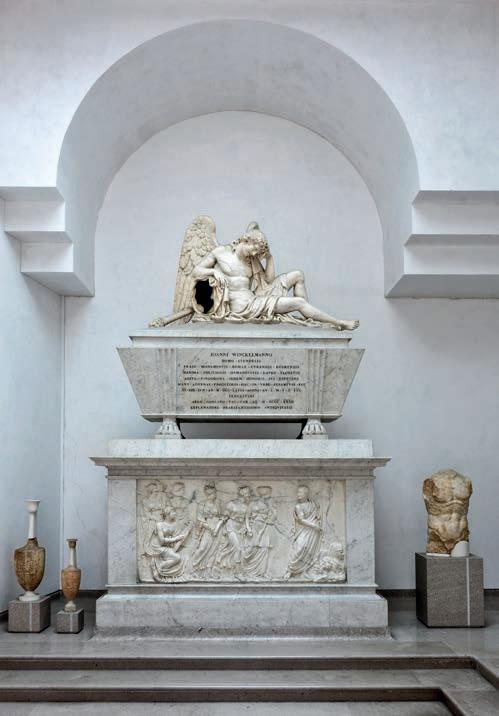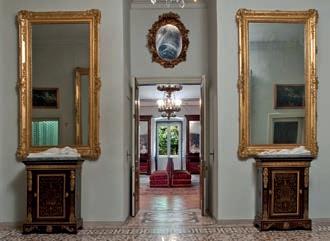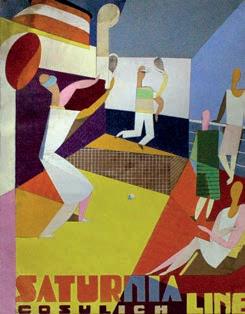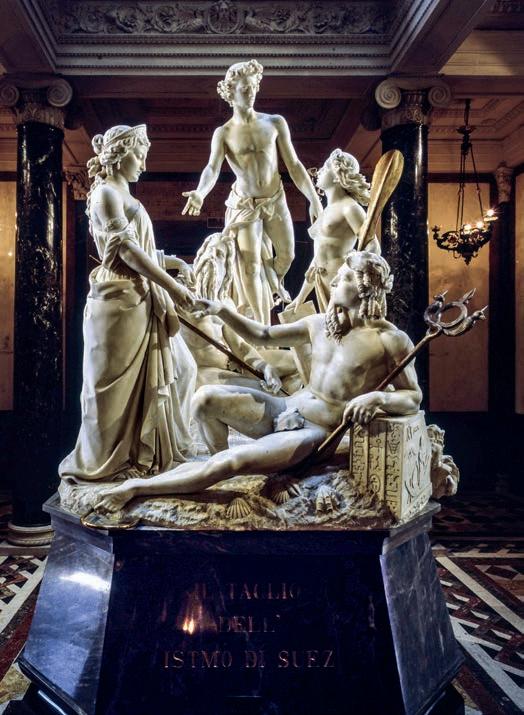
15 minute read
ARTE IN CITTÀ Art in the City
di /by
Lorenzo Michelli
Advertisement
A sinistra: L'opera di Giuseppe Santomaso, Primavera sul fiume del 1955 è conservata al Museo Revoltella di Trieste Il viaggio per vedere cose belle, per conoscere, arricchirsi, divertirsi. Si viaggia verso una città e si può viaggiare in città. Trieste, città moderna, nell’Ottocento si dota di musei, biblioteche e archivi. Si formano via via collezioni, poi incrementate, ordinate e riallestite nel corso del tempo. Così, entrando nei musei triestini si percepiscono orientamenti, suggestioni e altre visioni, anche lontane, nel tempo e nello spazio. Musei come porte per le camere delle meraviglie e per l’arte che ci conduce verso altre storie, narrazioni e idee, curiosità. A journey to see beautiful things, to discover, enrich, have fun. You travel to a city and you can travel around the city. Trieste, a modern city, in the nineteenth century museums, libraries and archives were built. Collections were gradually created, then increased, ordered and rearranged over time. Thus, as you enter Trieste’s museums, you can perceive other trends, suggestions and visions, even distant ones, in time and space. Museums as doors to the rooms of wonders and art that leads us to other stories, stories and ideas, curiosities.


Museo d’Antichità ‘J.J. Winckelmann’
Sul colle di San Giusto oltre alla Cattedrale e il castello fortezza che domina Trieste, vi è il fascinoso Giardino del Capitano con il Lapidario e il Museo d’Antichità, tra i luoghi della città più carichi di suggestioni. Suggestioni legate all’arte, a quella antica appunto, anche per la presenza del cenotafio dedicato a Johann Joachim Winckelmann, illustre archeologo e storico dell’arte che, di passaggio a Trieste, vi trovò la morte nel 1768. Il monumento venne realizzato grazie a Domenico Rossetti, personalità d’eccezione dell’epoca che si adoprò per la realizzazione di quest’opera legata al celebre teorico propugnatore della “nobile semplicità e della quieta grandezza” degli antichi. — On the hill of San Giusto, besides the Cathedral and the fortress castle that dominates Trieste, there is the fascinating Captain’s Garden with the Lapidarium and the Museum of Antiquities, among the most evocative places in the city. The presence of the cenotaph dedicated to Johann Joachim Winckelmann, an illustrious archaeologist and art historian who died in Trieste in 1768. The monument was created thanks to Domenico Rossetti, an exceptional personality of the time who worked for the creation of this work linked to the famous theorist who advocated the “noble simplicity and quiet greatness” of the ancients.


Museo Sartorio


Si tratta di una casa museo che documenta le predilezioni dei proprietari, i Sartorio, illustre famiglia proveniente da Sanremo qui trapiantata con successo, e lo stile di un’epoca. Salotti e salottini, cucine e biblioteche; pitture, affreschi, ceramiche; attrazione per la storia, per l’arte del giardinaggio. Tutto questo si ricava da una visita al Museo Sartorio. Oggi, questa casa museo, è dotata anche di una gipsoteca/gliptoteca e possiede una delle collezioni più ricche di disegni di Gianbattista Tiepolo del mondo. — It is a house museum that documents the preferences of the owners, the Sartorio, an illustrious family from Sanremo who were successfully transplanted here, and the style of a period. Living rooms and sitting rooms, kitchens and libraries; paintings, frescoes, pottery; attraction for history, for the art of gardening. It is a house museum that documents the preferences of the owners, the Sartorio, an illustrious family from San Remo who were successfully transplanted here,x and the style of an era. Living rooms and sitting rooms, kitchens and libraries; paintings, frescoes, ceramics; attraction for history, for the art of gardening. All this can be gained from a visit to the Museo Sartorio. Today, this house museum also has a gypsotheque/glyptotheque and one of the richest collections of paintings by Gianbattista Tiepolo in the world.
Città emporiale, di banche, assicurazioni, compagnie di navigazione. Da Trieste si poteva partire settimanalmente per viaggi lunghi, per luoghi lontani. È una città, per sua natura, legata alle cose remote, a ciò che si immagina, all’esotico. È un luogo in cui, già nell’Ottocento, c’era un particolare emporio, una galleria-negozio: il Gabinetto Cinese Wünsch cui erano disponibili preziosità orientali. Ora al museo sono esposte molte opere pervenute appunto, per lasciti e donazioni e acquisti, grazie a quei viaggi che collegavano Trieste con il mondo, attraverso le rotte marittime commerciali, poi anche di svago. Le stampe giapponesi dell’Ukiyo-e ci trasportano verso il mondo fluttuante.

City of emporials, banks, insurance companies, shipping companies. From Trieste you could leave on a weekly basis for long journeys to distant places. It is a city, by its nature, linked to remote things, to what one imagines, to the exotic. It is a place where, already in the nineteenth century, there was a particular emporium, a gallery-store: the Chinese Cabinet Wünsch to which were available oriental treasures. Now the museum exhibits many works of art that have been received for bequests, donations and purchases, thanks to those journeys that connected Trieste with the world, through commercial maritime routes, and then also for entertainment. The Japanese prints of the Ukiyo-e transport us to the floating world.



Bozzetto pubblicitario
Saturnia Cosulich Line
Tecnica mista – tempera e collage Augusto Cernigoj
Nella pagina a fianco: Bozzetto di copertina
Bollettino mensile del Lloyd Triestino: Anno V - n. 1,gennaio 1925
China e acquarello su carta Giuseppe Petronio
Civico Museo del Mare Polo Museale Magazzino 26
Mare e cultura del mare; viaggiare per ben viaggiare. Tra le decine di artigiani ed artisti che lavorarono per le celebri navi bianche –molte delle quali disegnate da Pulitzer Finaly, progettista, viaggiatore egli stesso e interprete di stili– vi è anche Augusto Cernigoj, avanguardista triestino. Egli frequentò una scuola d’eccezione il Bauhaus, che certamente favorì la nascita di uno stile molto personale. Quando lavorò per le navi il suo linguaggio costruttivista si sciolse in piacevoli e molto attuali arditezze compositive. — Sea and culture of the sea; travelling for travelling well. Among the dozens of craftsmen and artists who worked for the famous white ships –many of them designed by Pulitzer Finaly, designer, traveller himself and interpreter of styles– there is also Augusto Cernigoj, an avant-garde artist from Trieste. He attended the Bauhaus, an exceptional school, which certainly fostered the birth of a very personal style. When he worked for the ships his constructivist language dissolved into pleasant and very modern daring arrangements.


Museo Revoltella
Il Museo Revoltella è un insieme estremamente composito. Si va dagli eclettici saloni ottocenteschi, progettati da Friedrich Hitzig, alle articolazioni spaziali, i pieni/vuoti, di Carlo Scarpa, artefice del nuovo museo; dalle grandi tele figurative alle opere astratte, dalla pittura alle scultura, dalle fontane del pianoterra alle terrazze panoramiche. Tra i grandi protagonisti del ’900 triestino ci fu Marcello Mascherini che amò particolarmente il Revoltella condividendo gli sforzi di colori che agivano per un continuo aggiornamento. La sua opera Risveglio di primavera è posizionata vicino a una finestra della galleria del sesto piano, in una zona inondata di luce, in rapporto con il mare e il cielo di Trieste.


The Revoltella Museum is an extremely composite ensemble. It ranges from the eclectic nineteenth-century halls, designed by Friedrich Hitzig, to the spatial layouts, the full/empty spaces by Carlo Scarpa, creator of the new museum; from large figurative canvases to abstract works, from painting to sculpture, from ground floor fountains to panoramic terraces. Among the great protagonists of the 1900s in Trieste we can mention Marcello Mascheriniche, who was particularly fond of Revoltella and shared the efforts of the colours that worked for a continuous updating. His work Risveglio di primavera is set near a window in the gallery on the sixth floor, in an area flooded with light, in relationship with the sea and the sky of Trieste.
Lorenzo Michelli
Storico dell’arte ed esperto in attività museale, dal 1994 collabora con i principali musei triestini e regionali in qualità di curatore di mostre e progettista di allestimenti ed eventi culturali. Attualmente è responsabile della programmazione della Galleria Regionale d’Arte Contemporanea “Luigi Spazzapan” di Gradisca d’Isonzo. Recentemente ha curato la mostra “Trieste Settanta. Arte e sperimentazione” al Museo Revoltella di Trieste. — Art historian and expert in museum activities, has been collaborating with the most important museums in Trieste and in the region since 1994 as curator of exhibitions and designer of installations and cultural events. He is currently responsible for the programming of the Regional Gallery of Contemporary Art “Luigi Spazzapan” in Gradisca d’Isonzo. He recently curated the exhibition “Trieste Seventies. Art and experimentation” at the Revoltella Museum in Trieste.

ARTE IN CITTÀ
Art in the City
di /by Lorenzo Michelli
Il viaggio per vedere cose belle, per conoscere, arricchirsi, divertirsi. Si viaggia verso una città e si può viaggiare in città. Trieste, città moderna, nell’Ottocento si dota di musei, biblioteche e archivi. Si formano via via collezioni, poi incrementate, ordinate e riallestite nel corso del tempo. Così, entrando nei musei triestini si percepiscono orientamenti, suggestioni e altre visioni, anche lontane, nel tempo e nello spazio. Musei come porte per le camere delle meraviglie e per l’arte che ci conduce verso altre storie, narrazioni e idee, curiosità.
A journey to see beautiful things, to discover, enrich, have fun. You travel to a city and you can travel around the city. Trieste, a modern city, in the nineteenth century museums, libraries and archives were built. Collections were gradually created, then increased, ordered and rearranged over time. Thus, as you enter Trieste’s museums, you can perceive other trends, suggestions and visions, even distant ones, in time and space. Museums as doors to the rooms of wonders and art that leads us to other stories, stories and ideas, curiosities.
A sinistra: L'opera di Giuseppe Santomaso, Primavera sul fiume del 1955 è conservata al Museo Revoltella di Trieste


Museo d’Antichità ‘J.J. Winckelmann’
Sul colle di San Giusto oltre alla Cattedrale e il castello fortezza che domina Trieste, vi è il fascinoso Giardino del Capitano con il Lapidario e il Museo d’Antichità, tra i luoghi della città più carichi di suggestioni. Suggestioni legate all’arte, a quella antica appunto, anche per la presenza del cenotafio dedicato a Johann Joachim Winckelmann, illustre archeologo e storico dell’arte che, di passaggio a Trieste, vi trovò la morte nel 1768. Il monumento venne realizzato grazie a Domenico Rossetti, personalità d’eccezione dell’epoca che si adoprò per la realizzazione di quest’opera legata al celebre teorico propugnatore della “nobile semplicità e della quieta grandezza” degli antichi. — On the hill of San Giusto, besides the Cathedral and the fortress castle that dominates Trieste, there is the fascinating Captain’s Garden with the Lapidarium and the Museum of Antiquities, among the most evocative places in the city. The presence of the cenotaph dedicated to Johann Joachim Winckelmann, an illustrious archaeologist and art historian who died in Trieste in 1768. The monument was created thanks to Domenico Rossetti, an exceptional personality of the time who worked for the creation of this work linked to the famous theorist who advocated the “noble simplicity and quiet greatness” of the ancients.




Museo Sartorio
Si tratta di una casa museo che documenta le predilezioni dei proprietari, i Sartorio, illustre famiglia proveniente da Sanremo qui trapiantata con successo, e lo stile di un’epoca. Salotti e salottini, cucine e biblioteche; pitture, affreschi, ceramiche; attrazione per la storia, per l’arte del giardinaggio. Tutto questo si ricava da una visita al Museo Sartorio. Oggi, questa casa museo, è dotata anche di una gipsoteca/gliptoteca e possiede una delle collezioni più ricche di disegni di Gianbattista Tiepolo del mondo. — It is a house museum that documents the preferences of the owners, the Sartorio, an illustrious family from Sanremo who were successfully transplanted here, and the style of a period. Living rooms and sitting rooms, kitchens and libraries; paintings, frescoes, pottery; attraction for history, for the art of gardening. It is a house museum that documents the preferences of the owners, the Sartorio, an illustrious family from San Remo who were successfully transplanted here,x and the style of an era. Living rooms and sitting rooms, kitchens and libraries; paintings, frescoes, ceramics; attraction for history, for the art of gardening. All this can be gained from a visit to the Museo Sartorio. Today, this house museum also has a gypsotheque/glyptotheque and one of the richest collections of paintings by Gianbattista Tiepolo in the world.
Museo Orientale


Città emporiale, di banche, assicurazioni, compagnie di navigazione. Da Trieste si poteva partire settimanalmente per viaggi lunghi, per luoghi lontani. È una città, per sua natura, legata alle cose remote, a ciò che si immagina, all’esotico. È un luogo in cui, già nell’Ottocento, c’era un particolare emporio, una galleria-negozio: il Gabinetto Cinese Wünsch cui erano disponibili preziosità orientali. Ora al museo sono esposte molte opere pervenute appunto, per lasciti e donazioni e acquisti, grazie a quei viaggi che collegavano Trieste con il mondo, attraverso le rotte marittime commerciali, poi anche di svago. Le stampe giapponesi dell’Ukiyo-e ci trasportano verso il mondo fluttuante.
City of emporials, banks, insurance companies, shipping companies. From Trieste you could leave on a weekly basis for long journeys to distant places. It is a city, by its nature, linked to remote things, to what one imagines, to the exotic. It is a place where, already in the nineteenth century, there was a particular emporium, a gallery-store: the Chinese Cabinet Wünsch to which were available oriental treasures. Now the museum exhibits many works of art that have been received for bequests, donations and purchases, thanks to those journeys that connected Trieste with the world, through commercial maritime routes, and then also for entertainment. The Japanese prints of the Ukiyo-e transport us to the floating world.


Civico Museo del Mare Polo Museale Magazzino 26
Mare e cultura del mare; viaggiare per ben viaggiare. Tra le decine di artigiani ed artisti che lavorarono per le celebri navi bianche –molte delle quali disegnate da Pulitzer Finaly, progettista, viaggiatore egli stesso e interprete di stili– vi è anche Augusto Cernigoj, avanguardista triestino. Egli frequentò una scuola d’eccezione il Bauhaus, che certamente favorì la nascita di uno stile molto personale. Quando lavorò per le navi il suo linguaggio costruttivista si sciolse in piacevoli e molto attuali arditezze compositive. — Sea and culture of the sea; travelling for travelling well. Among the dozens of craftsmen and artists who worked for the famous white ships –many of them designed by Pulitzer Finaly, designer, traveller himself and interpreter of styles– there is also Augusto Cernigoj, an avant-garde artist from Trieste. He attended the Bauhaus, an exceptional school, which certainly fostered the birth of a very personal style. When he worked for the ships his constructivist language dissolved into pleasant and very modern daring arrangements.




Museo Revoltella


Il Museo Revoltella è un insieme estremamente composito. Si va dagli eclettici saloni ottocenteschi, progettati da Friedrich Hitzig, alle articolazioni spaziali, i pieni/vuoti, di Carlo Scarpa, artefice del nuovo museo; dalle grandi tele figurative alle opere astratte, dalla pittura alle scultura, dalle fontane del pianoterra alle terrazze panoramiche. Tra i grandi protagonisti del ’900 triestino ci fu Marcello Mascherini che amò particolarmente il Revoltella condividendo gli sforzi di colori che agivano per un continuo aggiornamento. La sua opera Risveglio di primavera è posizionata vicino a una finestra della galleria del sesto piano, in una zona inondata di luce, in rapporto con il mare e il cielo di Trieste.
The Revoltella Museum is an extremely composite ensemble. It ranges from the eclectic nineteenth-century halls, designed by Friedrich Hitzig, to the spatial layouts, the full/empty spaces by Carlo Scarpa, creator of the new museum; from large figurative canvases to abstract works, from painting to sculpture, from ground floor fountains to panoramic terraces. Among the great protagonists of the 1900s in Trieste we can mention Marcello Mascheriniche, who was particularly fond of Revoltella and shared the efforts of the colours that worked for a continuous updating. His work Risveglio di primavera is set near a window in the gallery on the sixth floor, in an area flooded with light, in relationship with the sea and the sky of Trieste.
Lorenzo Michelli

Storico dell’arte ed esperto in attività museale, dal 1994 collabora con i principali musei triestini e regionali in qualità di curatore di mostre e progettista di allestimenti ed eventi culturali. Attualmente è responsabile della programmazione della Galleria Regionale d’Arte Contemporanea “Luigi Spazzapan” di Gradisca d’Isonzo. Recentemente ha curato la mostra “Trieste Settanta. Arte e sperimentazione” al Museo Revoltella di Trieste. — Art historian and expert in museum activities, has been collaborating with the most important museums in Trieste and in the region since 1994 as curator of exhibitions and designer of installations and cultural events. He is currently responsible for the programming of the Regional Gallery of Contemporary Art “Luigi Spazzapan” in Gradisca d’Isonzo. He recently curated the exhibition “Trieste Seventies. Art and experimentation” at the Revoltella Museum in Trieste.










